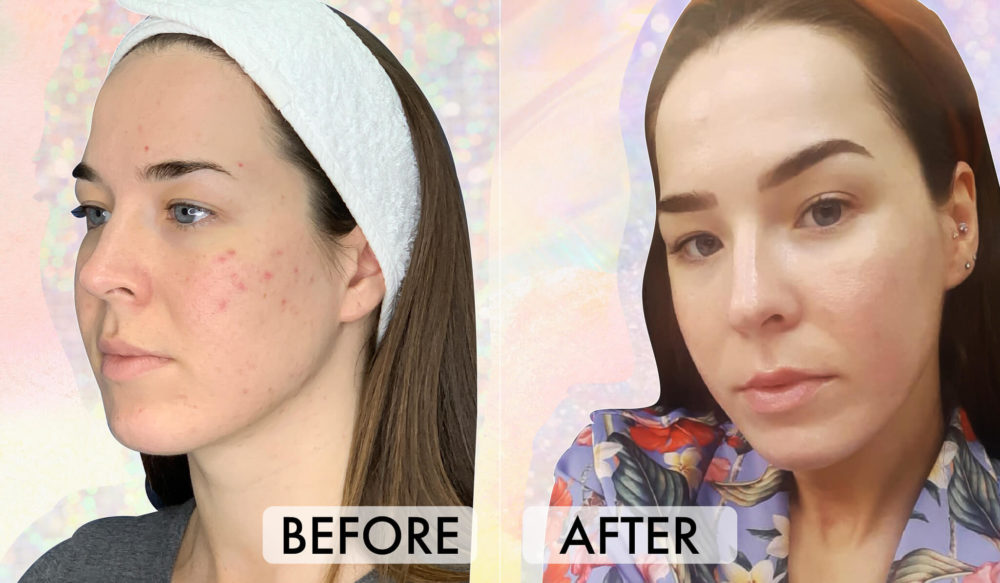Problems Using Retinol? Time To Try The Retinol Sandwich...
 via Giphy
via Giphy
Hands down, retinol is one of the best products you can add to your skincare regimen. This holy grail, derms-swear-by-it ingredient has an entire fleet of scientific articles to back up its efficacy, and it can literally reverse signs of aging.
“Retinol is one of the most well-studied topical skincare ingredients and is a bit of a miracle ingredient because it can do so many different things,” says Roberta Moradfar, celebrity aesthetics nurse practitioner and founder of EFFACÈ Aesthetics. “It can help clear acne, reduce hyperpigmentation, even skin tone, smooth rough texture, reduce the appearance of pores, firm skin, and visibly reduce wrinkles – even the deeper ones.”
The only catch? This lil’ hero is notoriously irritating, especially when you first start using it. While temporary, common side effects include redness, sensitivity, dryness, and peeling. It can even cause breakouts. These side effects last anywhere from a couple of weeks to a few months and are triggered whenever you go up in strength.
It’s annoying and frustrating, but totally #WorthIt for the long-game results. But we’ve got some real good news. You can reduce the intensity of this temporary reaction by leveraging the retinol sandwich skincare technique. Keep reading to learn what this skincare technique entails and how it might be the key to (finally!) incorporating this beloved ingredient into your regimen.
What is a Retinol Sandwich?
 via Giphy
via Giphy
A retinol sandwich is simply applying a moisturizer before and after applying retinol. “This helps to dampen the potency of the retinol while also ensuring you are providing your skin with enough moisture, which in turn keeps the skin barrier healthy,” explains skincare expert Jen Shane, an early adopter and pioneer of this technique. She’s also the co-founder and head of innovation at iNNBeauty Project.
By reducing the potency, you allow your skin to slowly get used to the retinol. On that note, retinol sandwiches are just meant to ease you into using this ingredient versus being a long-term technique. Basically, you want to gradually introduce your skin to the ingredient and, over time, increase the exposure so you enjoy the anti-aging benefits of retinol.
Along with retinol newbies, “the retinol sandwich can be a good choice for those with dry or sensitive skin,” says Dr. Akis Ntonos, a board-certified aesthetic dermatologist and co-founder of Aion Aesthetics.
Posts You'll Love:
How to Use the Retinol Sandwich Method
Want to learn how to do a retinol sandwich? The key is to make sure you’re using the right products.
1. Use a Gentle Cleanser
Cleanse your skin per usual using a gentle, non-exfoliating cleanser that’s free of any actives, such as AHAs or BHAs. Gently pat dry – do not rub.
2. Apply Oil-Free Moisturizer
Apply a thin layer of moisturizer to your freshly cleaned skin. “In order to minimize some of the side effects and get better results with a retinol sandwich, try to use a moisturizer that is non-oil based and allow for it to absorb after the first application before you apply the retinol,” Dr. Ntonos advises. The moisturizer should also be free of any active ingredients.
3. Apply Retinol
After about 30 seconds, apply a thin layer of a high-quality retinol on top of the moisturizer. Shane says, “Avoid really sensitive areas on the face like around the nostrils, corners of the mouth, and the delicate eye area.”
Some expert-recommended retinol options include:
- SkinMedica Retinol Complex 0.5, $80
- Obagi Medical Obagi360 Retinol 0.5, $73
- iNNBeauty Project Retinol Remix 1% Retinol Treatment With Peptide & Tranexamic Acid, $48
- Shani Darden Skin Care Retinol Reform Treatment Serum, $88
4. Re-Apply Moisturizer
Wait another 30 seconds, then re-apply another layer of moisturizer on top.
More Pro Tips for Reducing Retinol Side Effects
 via Giphy
via Giphy
Start Slow: If you’re new to retinol, start slow. Aim for one to two times a week and monitor your skin. If you aren’t experiencing irritation, work your way up to nightly use. From there, work up in formula concentrations.
Only Apply to Healthy Skin: Dr. Ntonos says, “Do not use retinol products on irritated, sunburned or scaly skin, including wounds.”
Apply SPF: You should wear sunscreen every day. However, you definitely don’t want to forget to apply when using retinol, and you should be consistent with reapplications throughout the day. Check out some of our fave sunscreens here.
Just not sold on retinol? No sweat. Consider one of these top-tier retinol alternatives for sensitive skin!























Leave a comment